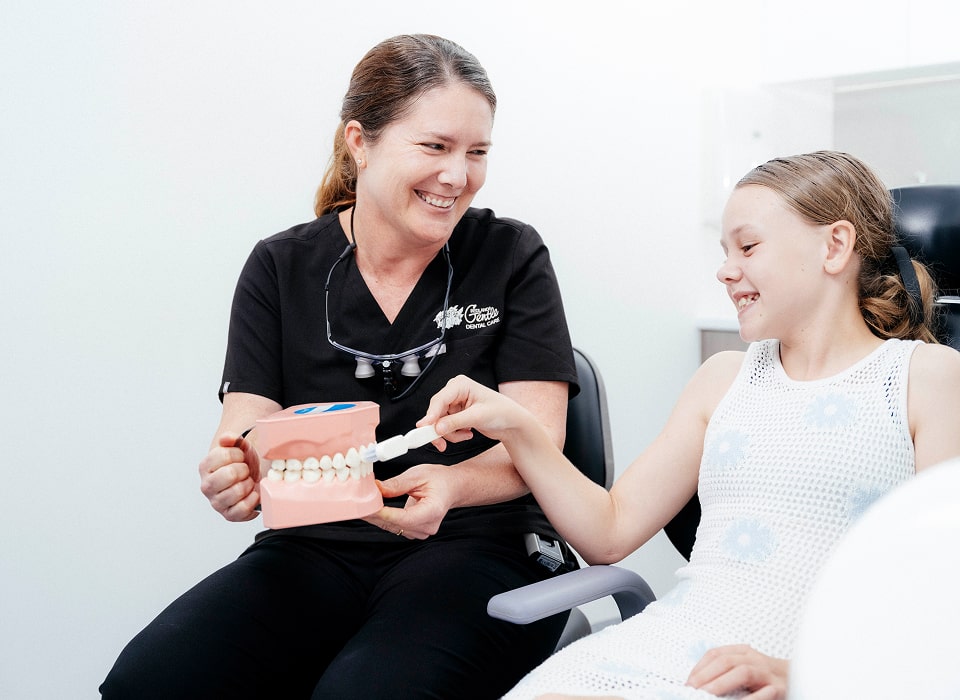Your Journey to a Straighter, Beautiful-Looking Smile Starts With Invisalign in Brisbane Today
Why Choose Us
Choose Redlands Gentle Dental Care for Your Invisalign Treatment
At Redlands Gentle Dental Care, we provide personalised Invisalign treatment using advanced technology and a patient-focused approach. Serving Brisbane and nearby suburbs, we help patients work towards a straighter smile with customised treatment plans, flexible payment options, and decades of trusted dental care.

Certified Invisalign Provider

State-of-the-Art Technology

40 Years of Dedicated Service
and Building Healthy Smiles

Accessible Payment Plans
and Transparent Pricing

What Makes Invisalign Aligners the Preferred Choice for Straightening Teeth
Two Convenient Locations
Quality Dental Services Made Accessible for Families in the Victoria Point and Capalaba Areas
Capalaba Dental Clinic
- (07) 3245 5511
- 149 Old Cleveland Rd Capalaba, QLD, 4157
- Free Parking Available
Victoria Point Dental Clinic
- (07) 3820 7777
- 2/1 Bunker Road, Victoria Point, QLD, 4165
- Free Parking Available
Custom Treatments
Explore Our Personalised Approach to Invisalign Treatment for Straight, Confident Smiles
Learn About Invisalign Treatment Options at Your First Consultation
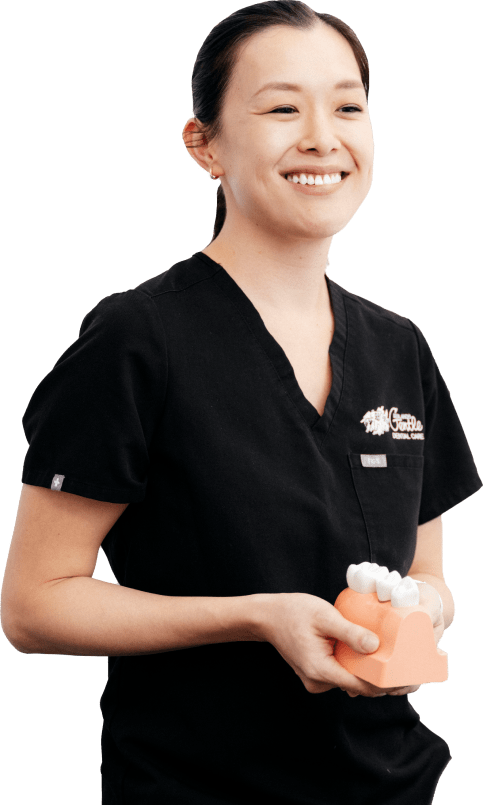
Experience the Difference of Gentle Care with Us
How We Can Help
Learn How Invisalign Can Address Your Dental Problem
Unhappy With My Smile
Considering Teeth Straightening
Seeking Smile Improvement
Invisalign Success Stories of Redlands Gentle Dental Care Patients
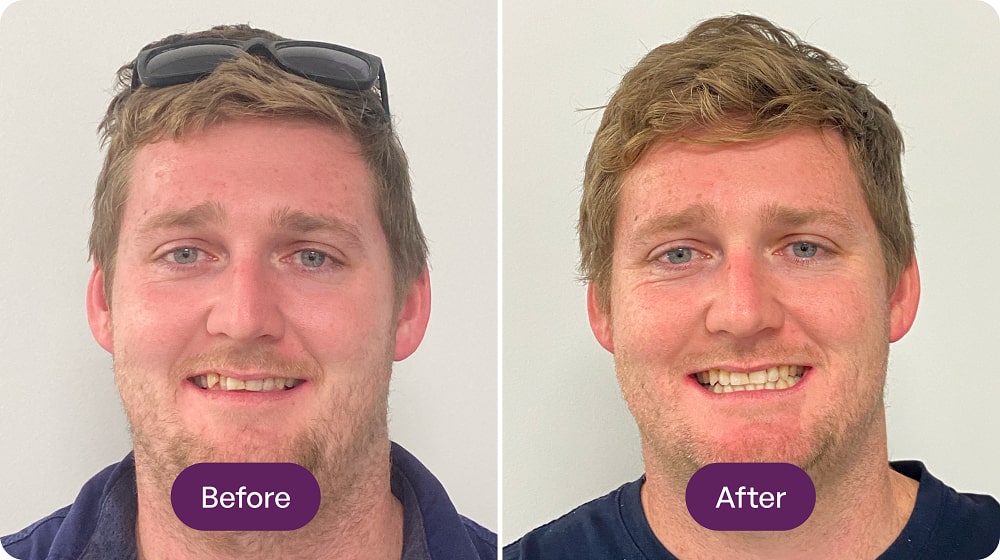
Ciaran, 28 years old
Treatment: Moderate case
Duration: 12 months
Ciaran, a 28-year-old patient, wanted to enhance his smile and improve his bite, and we were excited to help him achieve his goals! Under the professional guidance of Dr. Chris, he underwent a 12-month Invisalign journey that resulted in a beautifully aligned smile. His transformation speaks for itself—straight, confident, and life-changing! His before and after photos highlight the amazing transformation he underwent.
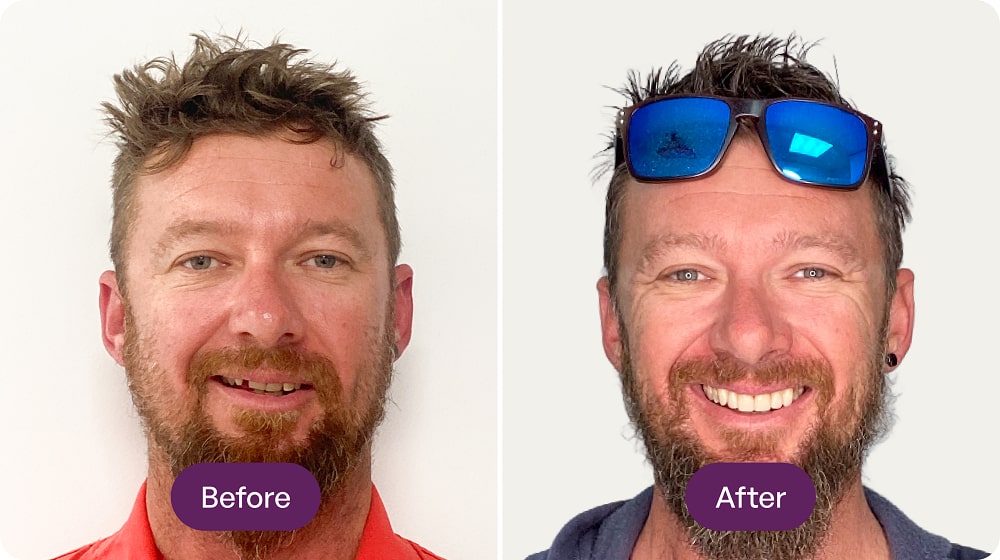
John, 41 years old
Treatment: Lite case
Duration: 5 months
John came to us looking to improve his smile. As a busy dad of 3, he wasn’t happy with his teeth and felt it was time to invest in his dental health and happiness. A treatment plan was devised utilising a combination of restorations, crowns and bridges. The results speak for themselves. John was a great patient to treat and all the team enjoyed seeing him grow in confidence and entertain us with his friendly conversations.
*These images display actual patients of our clinic. Every case is different, and treatment outcomes can vary according to individual conditions and needs.
Smile Gallery
From Crooked Smiles to Confident Smiles, Invisalign Makes It Happen


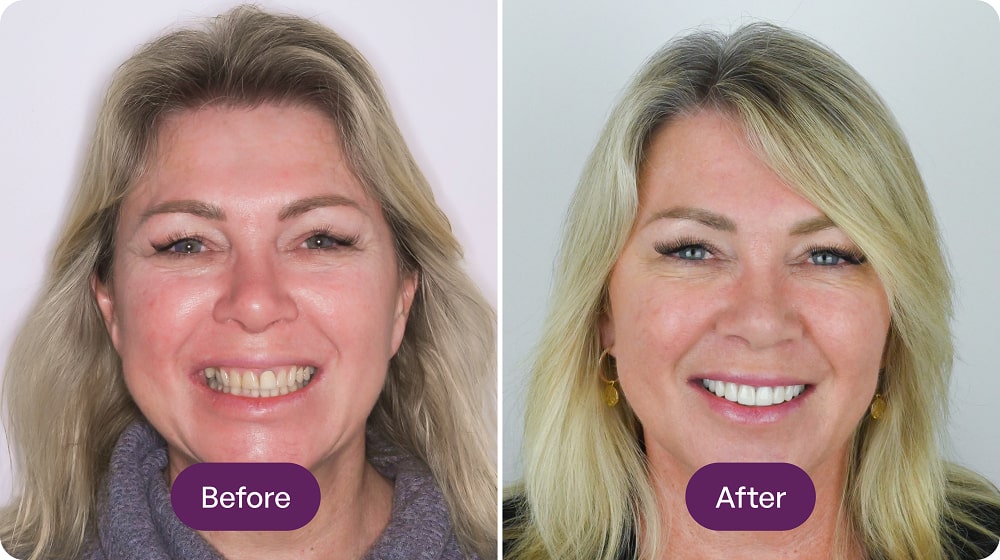
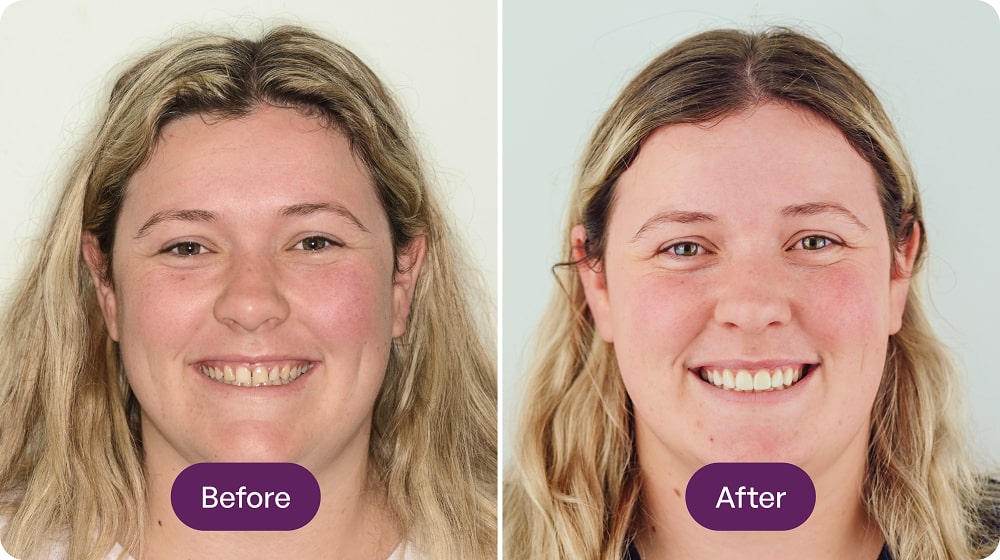
*These images display actual patients of our clinic. Every case is different, and treatment outcomes can vary according to individual conditions and needs.
Our Payment Options
Find What Works for Your Financial Needs With Our Dental Payment Options
Child Dental Benefits Schedule
Invest in your child's smile with the Child Dental Benefits Schedule (CDBS). This government program offers eligible families financial support for essential dental services, promoting good oral health habits from an early age.
The CDBS covers up to $1,095 over two years for basic dental care like check-ups, cleanings, and fillings for children aged zero to 17. Eligibility depends on Medicare status and specific government payments, making quality dental care more accessible to families.
Learn MoreDental Services for DVA Card Holders
Veterans deserve high-quality dental care, and the Department of Veterans' Affairs (DVA) program delivers just that. The program offers dental benefits that vary based on card type.
Gold Card holders receive comprehensive cover for clinically necessary treatments, from routine check-ups to advanced procedures. White Card holders are covered for dental care related to accepted service-related conditions or mental health needs. Our clinic proudly supports veterans by providing high-quality dental care to maintain their overall health.
Learn MoreHumm
Simplify your dental care payments with Humm, a flexible financing option that lets you smile now and pay later. This interest-free payment plan allows you to spread the cost of your dental treatments over time, making essential care more accessible.
Humm is available for various dental services, from routine check-ups to more complex procedures. With instant approval and the ability to manage your account online, Humm helps you prioritise your oral health without financial stress.
Learn MoreZip
We offer Zip to help patients manage treatment costs. With credit limits between $1,000 and $50,000, eligible patients can select flexible repayment terms from three to 60 months, making it easier to manage costs.
Zip is ideal for anyone needing dental care without upfront costs. The user-friendly app allows you to track payments easily, so you can stay on budget while prioritising your oral health.
Learn MoreSuperCare
With the help of SuperCare, eligible patients can release their superannuation funds early to access essential dental procedures. This option is suitable for families lacking sufficient health funds or available resources, covering services such as orthodontics, implants, and root canal therapies.
SuperCare's consultants guide you through the straightforward application process, simplifying what can often be complex. This service enables you to prioritise your family's oral health without the burden of upfront costs.
Learn MoreAfterPay
Experience the convenience of dental care with Afterpay, allowing you to receive treatments now and pay later in four easy instalments over six weeks. This payment option is available to anyone over 18, a practical choice for adults looking to enhance and maintain oral health.
With no interest charges when payments are made on time, Afterpay promotes responsible budgeting. Payments are automatically deducted from your linked debit or credit card for a smooth experience.
Learn MoreBupa Preferred Provider
Enjoy exclusive benefits and hassle-free claims when you choose our clinic, a Bupa Preferred Provider, for your dental health needs. Our patients can access a comprehensive range of services, including check-ups and major procedures, often at reduced out-of-pocket costs.
Members First Ultimate also offers 100% back on two dental check-ups and cleans every six months, making regular oral care more affordable. Our partnership with Bupa allows you to receive quality care while maximising your benefits.
Learn MoreHCF Preferred Provider
Experience affordable, high-quality dental care at Redlands Gentle Dental Care. As an HCF preferred provider, patients with eligible dental cover can access reduced out-of-pocket costs, no-gap services for selected treatments, and streamlined claims processing.
HCF members can take advantage of these benefits by choosing our clinic for their dental needs. Check your policy to understand covered treatments and annual limits, and let us help you achieve a healthier, brighter smile.
Learn Morenib Preferred Provider
Access professional dental care at our clinic, a trusted part of nib's First Choice network. As a nib Preferred Provider, we offer members the opportunity to receive quality dental care at agreed rates. This provides a transparent and straightforward experience for your dental needs.
Nib members benefit from reduced out-of-pocket costs and simplified claims processes at our clinic. To make the most of your cover, review your policy for applicable limits and service inclusions.
Learn MoreInvisalign Treatment Guide
Frequently Asked Questions
What is the difference between Invisalign and other orthodontic treatment options?
Choosing between Invisalign and traditional metal braces depends on your lifestyle, preferences, and treatment needs. While both are effective, their methods and benefits differ significantly.
Here’s a clear comparison to help you understand which option might be right for you:
| Feature | Invisalign | Traditional Metal Braces | Other Clear Aligners |
| Appearance | Nearly invisible clear aligners | Visible brackets and wires | Clear aligners are similar to Invisalign; some brands may have slight differences in clarity or fit. |
| Removability | Removable aligners for eating, drinking, and cleaning | Brackets and wires cannot be removed until treatment is complete | Removable aligners for eating, drinking, and cleaning. |
| Comfort | Smooth plastic aligners; minimal irritation to gums and cheeks | Brackets and wires may cause irritation or sores inside the mouth | Smooth plastic aligners; comfort levels may vary depending on the brand and material used. |
| Customisation & Precision | Utilises advanced 3D imaging technology for precise tooth movement; custom-made for each patient. | Effective for complex dental issues; may require more frequent adjustments | Varies by provider; some offer comprehensive digital planning, while others may have limitations in customisation. |
| Dietary Restrictions | No dietary restrictions; aligners can be removed during meals | Requires avoiding sticky, hard, or crunchy foods that could damage braces | No dietary restrictions; aligners can be removed during meals. |
| Oral Hygiene | Easier to maintain oral hygiene; aligners can be removed for brushing | Brushing and flossing require extra care to clean around brackets and wires | Easier to maintain oral hygiene; aligners can be removed for brushing. |
| Adjustments | Aligners are switched every 1–2 weeks with fewer dental visits | Regular appointments are needed to tighten wires and make adjustments | Aligners are typically switched every 1–2 weeks; the frequency of dental visits varies by provider. |
| Treatment Duration | Usually 6–24 months, depending on individual cases | Similar timeframe but varies based on case complexity | Varies depending on the provider and complexity of the case; often similar to Invisalign for mild to moderate cases. |
| Discomfort | Mild pressure during aligner changes; generally more comfortable | May cause discomfort during adjustments or due to wire pokes | Mild pressure during aligner changes; comfort levels may vary depending on the brand and material used. |
| Cost | $6,000 – $9,000 for full treatment, depending on case complexity, treatment duration, and provider; flexible payment plans available. | $3,000 – $7,500, depending on complexity and duration | $2,700 – $8,000, depending on provider and treatment needs |
| Technology Used | Utilises SmartTrack material and iTero scanner for precision | Traditional metal brackets and wires; newer options may include ceramic or lingual braces | Varies by provider; some use advanced 3D imaging technology, while others may have different approaches. |
| Aesthetic Appeal | High aesthetic appeal due to near invisibility | Lower aesthetic appeal due to visible metal components | High aesthetic appeal similar to Invisalign; however, quality and clarity may vary by brand. |
| Flexibility for Lifestyle | Ideal for Brisbane’s active lifestyle, aligners can be removed during sports or outdoor activities | Fixed braces can pose challenges during sports or physical activities | Removable like Invisalign |
How does Invisalign work?
Invisalign clear aligners use advanced technology and a series of custom trays to address teeth straightening issues, such as crowded teeth or gaps, while creating a more confident smile.
- SmartTrack Material:
Invisalign aligners are made from SmartTrack material, a flexible thermoplastic designed to fit comfortably. Unlike braces, this material provides consistent pressure to straighten your teeth effectively while remaining virtually invisible. - Custom aligners:
Each aligner is crafted using advanced 3D imaging technology to precisely fit your teeth. These aligners are removable and comfortable, helping reduce the discomfort often associated with traditional braces. - Mechanism of action:
Aligners apply gentle, steady pressure to shift teeth incrementally into position. A new aligner is used every one to two weeks, progressing the treatment gradually. - Wear duration:
Aligners must be worn for 20–22 hours daily, only removed to eat, drink, brush, or floss your teeth. This allows for effective progress while maintaining oral hygiene by preventing food particles from getting trapped. - Treatment timeline:
Invisalign treatment usually lasts 6-24 months, depending on what your teeth require. Many patients in Brisbane notice visible improvements within weeks. - Predictable results:
Each aligner set follows a carefully planned sequence, helping achieve consistent progress. Regular appointments monitor your alignment and may include providing Invisalign retainers after treatment.
This step-by-step process highlights the advantages of Invisalign—discreet, removable, and tailored to fit naturally into your routine, making it an ideal option for those feeling self-conscious about traditional braces.
What age is appropriate for Invisalign?
Invisalign for teeth straightening is generally suitable for individuals of all ages as long as their teeth and gums are healthy enough for orthodontic treatment. Children can start as early as 6-10 years old, especially if they have minor crowding, spacing issues, or other early teeth straightening needs.
Teenagers and adults can also benefit from Invisalign, which addresses many orthodontic concerns. During the initial consultation, the dentist assesses the teeth and recommends the appropriate treatment options based on individual needs.
Who is not a suitable candidate for Invisalign?
Invisalign aligners may not be suitable for everyone, and certain factors can make them less effective or practical:
- Severe alignment problems:
Other orthodontic approaches may benefit individuals with significant bite issues, extreme misalignment, or complex dental alignment needs. - Existing dental health issues:
People with active problems, such as cavities, gum disease, or infections, should address these before starting aligner treatments. - Inconsistent wear:
Invisalign aligners must be worn for 20–22 hours daily. Those who cannot consistently follow this may not see the expected teeth movements. - Extensive tooth rotations or movements needed:
Invisalign works well for moderate tooth movements, gaps between teeth, or minor crowding. However, cases requiring large shifts or rotations may not be manageable with this method. - Young children without full dental development:
While Invisalign can be an option for ages 6-10, young children with numerous baby teeth or immature jaw development may not qualify.
During a consultation, your dentist will assess your needs and determine whether Invisalign is the appropriate treatment for your teeth alignment goals.
Is Invisalign painful?
Invisalign is not considered painful, but some patients may experience mild discomfort, especially when starting a new set of aligners. This is normal, as the aligners guide your teeth through small, gradual movements.
- Initial discomfort:
When switching to a new aligner, you may feel pressure on your teeth. This sensation usually lasts a few days and is a sign that the aligners are working to move your teeth. - No sharp edges:
Unlike traditional braces, Invisalign aligners are smooth and custom-fitted, making them a more comfortable treatment option for many people. - Managing discomfort:
Any mild soreness can usually be managed by wearing the aligners consistently and following good Invisalign maintenance practices, such as proper cleaning and regular appointments.
Invisalign offers a comfortable way to achieve straighter teeth with minimal and temporary discomfort. Multiple sets of aligners, worn 20–22 hours a day, gradually guide teeth into the desired position without brackets, wires, or rubber bands.
Will Invisalign affect my speech?
Invisalign may cause a slight lisp or changes in speech during the first few days as you adjust to the aligners. These changes are usually temporary, and most people can speak quickly after a short period. Unlike metal wires in other dental treatments, the smooth design of the aligners makes it easier to adapt.
Wearing the aligners consistently for the recommended time each day helps improve speech quickly. Most individuals find that their ability to speak naturally returns throughout Invisalign treatment.
Do you wear Invisalign all day?
Invisalign must be worn for 20–22 hours daily to support gradual and consistent teeth movement. They should only be removed for eating, drinking, brushing, and flossing.
Invisalign maintenance involves cleaning the aligners regularly to prevent buildup and keep them clear and comfortable. Proper care also helps maintain their effectiveness throughout the day.
One of the benefits of Invisalign is the flexibility to remove the aligners when needed, unlike traditional braces. Consistent wear is crucial to achieving progress throughout the Invisalign treatment.
How long do you have to wear Invisalign?
Wearing Invisalign aligners for the recommended 20–22 hours daily is essential for addressing crooked teeth and moderate crowding. Most patients wear the aligners for a duration of Invisalign treatment ranging from 6-24 months, depending on the complexity of their case. Each set of aligners applies gentle pressure to guide teeth gradually into proper alignment.
These invisible braces allow you to remove them for eating and cleaning, which helps maintain good oral health. Progress is achieved by switching to new sets of aligners every one to two weeks, with consistent use helping to deliver a straighter smile over time.
How many trays of Invisalign are needed to see results?
The number of trays required for Invisalign depends on the complexity of your alignment needs. Each case is personalised, and the number of aligners is determined by the severity of the misalignment and your treatment plan.
- Mild to moderate cases:
8-14 trays are often needed for mild misalignment or small gaps. Many patients start seeing noticeable improvements within a few weeks. The entire treatment duration for these cases is around six months. - Extensive orthodontic needs:
For more complex cases, such as significant misalignment, underbites, or overbites, 15-30 aligners may be required. Progress becomes visible after a few months, with the treatment lasting 12-18 months.
Each aligner is worn for one to two weeks before switching to the next. Consistent wear and good Invisalign maintenance practices help guide teeth effectively towards the desired alignment.
How often do I need to visit my dentist at Redlands Gentle Dental Care for check-ups during Invisalign treatment?
During Invisalign treatment, you must visit the dentist every 6-8 weeks. These appointments allow the dentist to monitor your progress and provide new sets of aligners.
One of the benefits of Invisalign for teeth straightening is that it requires fewer visits than traditional braces. Traditional braces often need adjustments every 4-6 weeks, while Invisalign’s pre-designed aligners guide gradual teeth movement, reducing the frequency of appointments. These regular check-ups keep your treatment on track and address any issues if needed.
Can you drink coffee with Invisalign?
You can drink coffee with Invisalign but you must remove the aligners first. Drinking coffee while wearing them can cause staining, and hot beverages may damage the aligners.
After drinking coffee, brushing your teeth or rinsing your mouth before putting the aligners back in is essential. This helps keep the aligners clean and prevents trapping coffee residue, which could affect oral hygiene and your treatment progress. Proper Invisalign maintenance is key to maintaining the aligners clear and functional.
How do I clean and care for my Invisalign aligners?
Proper cleaning and care are essential to keep Invisalign aligners clear, hygienic, and effective. Follow these steps for daily maintenance:
- Rinse regularly:
Rinse your aligners with lukewarm water every time you remove them to prevent saliva and bacteria buildup. - Brush gently:
To clean your aligners, use a soft-bristled toothbrush and mild, clear soap. Avoid toothpaste, as it can scratch the surface and make them appear cloudy. - Soak daily:
Soak your aligners in Invisalign cleaning crystals or a denture-cleaning solution once daily. This helps remove any stubborn plaque or odours. - Avoid hot water:
Never expose your aligners to hot water, as it can warp the plastic and affect their fit. - Store safely:
When not in use, always store your aligners in their protective case to avoid damage or loss.
By following these steps, you can maintain clear and clean aligners while protecting your oral health throughout the treatment process.
What should I do if I lose or damage an aligner?
If you lose or damage an aligner, contact your dentist immediately. They will assess your progress and advise you on the steps to avoid disrupting your treatment.
Here’s what you can do in the meantime:
- Move to the next aligner:
If it’s close to the time to switch, your dentist may recommend moving to the next set of aligners. - Use the previous aligner:
If switching early isn’t advised, wearing the previous aligner can help maintain teeth positions until a replacement is provided. - Order a replacement:
In some cases, the dentist may order a new aligner to replace the lost or damaged one.
When not in use, it’s important to keep your aligners in their case to prevent loss or damage. Acting quickly helps minimise disruptions to your treatment progress.
Do your teeth shift back after completing Invisalign treatment?
Teeth can shift slightly after Invisalign if proper aftercare is not followed. To maintain the results and prevent movement, wearing a retainer as recommended by your dentist is essential. Retainers help hold teeth in their new positions and are a key part of long-term maintenance.
One of the benefits of Invisalign is that retainers are custom-made and designed to be as comfortable and discreet as the aligners. With consistent use of a retainer, you can protect your straight smile and minimise the risk of shifting over time. Regular follow-ups with your dentist will also help monitor your alignment and address concerns.
What happens after I complete my Invisalign treatment?
After completing your Invisalign treatment, your dentist will recommend wearing retainers to maintain your newly aligned teeth. Retainers are custom-made to fit your mouth and help keep your teeth in their final positions, preventing them from shifting back over time.
You may need to wear your retainers full-time initially and then transition to wearing them only at night, as advised by your dentist. Regular follow-up appointments will also be scheduled to monitor your oral health and the stability of your alignment.
What is the average cost of Invisalign in Brisbane?
The cost of Invisalign for teeth straightening depends on several factors. These include:
- Case complexity:
Minor alignment issues, such as small gaps or mild crowding, generally cost less. More complex cases requiring significant adjustments may need additional aligners, increasing the cost. - Treatment duration:
Longer treatments involve more aligners and appointments, which can raise the overall price. Shorter treatments for minor adjustments typically cost less. - Location:
Pricing can vary depending on the clinic and region, with some areas having higher treatment costs. - Additional treatment details:
Costs may include retainers, refinements, or other adjustments needed during the process.
For those considering Invisalign in Brisbane, treatment costs generally range from $5,000 to $9,000, depending on individual needs.
At Redlands Gentle Dental Care, our Invisalign packages start at $5,500. This includes retainers and tooth-whitening gel. During your consultation, our dental team will evaluate your needs and provide a cost estimate based on your treatment plan. Flexible, interest-free payment plans are available to make achieving a straighter smile more accessible for every budget.
